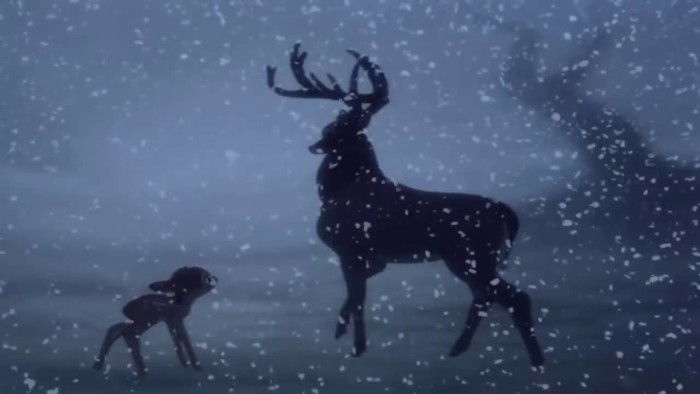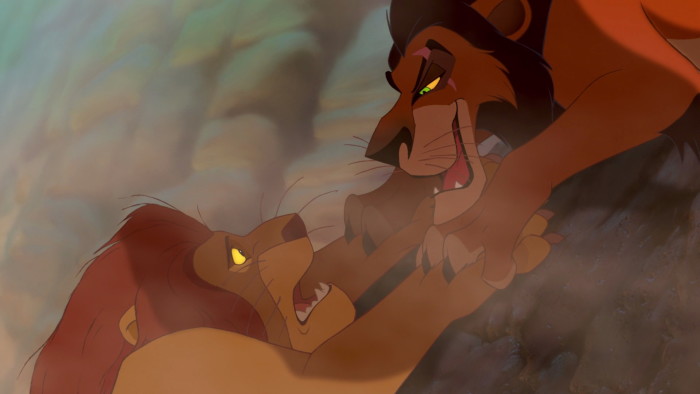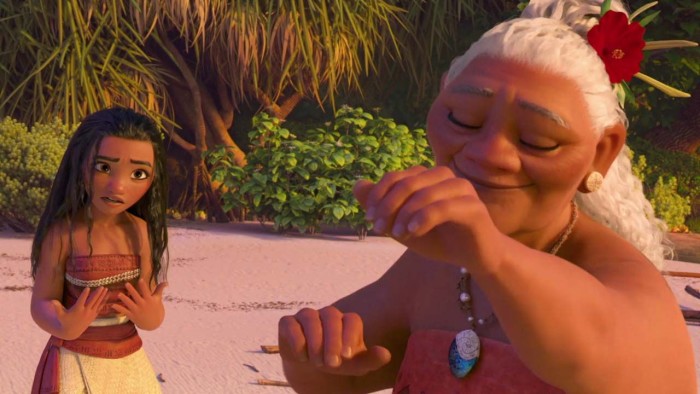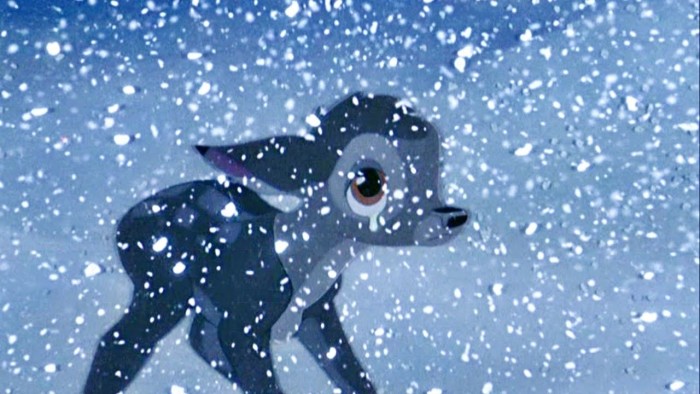'The Lion King,' 'Bambi' And Why Disney Movies Shouldn't Be Afraid Of Death
(Welcome to The Disney Discourse, a recurring feature where Josh Spiegel discusses the latest in Disney news. He goes deep on everything from the animated classics to the theme parks to live-action franchises. In this edition: why Disney movies shouldn't be afraid of death.)
Few moments in American cinema stick with people from their youth through adulthood as much as the death of Bambi's mother midway through the 1942 Disney animated classic Bambi. (Her death was the focal point of one of the truly great entries in Gary Larson's dearly departed The Far Side comic strip.) This murder, caused by an offscreen hunter, is handled as carefully and artfully as possible. We don't see anything, not even a hint of the gruesome aftermath, just the echoing sound of shotgun shells. Then, the young Bambi is gruffly told by his largely absent father, the Great Prince of the Forest, that "Your mother can't be with you anymore" as snow falls over the young deer's furry face. This is a standout sequence in Disney animation not just because it's emotional or beautifully rendered. It depicts something that almost never actually happens in the Disney canon: death.
Death is a spectre in Disney animation, but rarely is it visited upon the lead characters of such films. A couple of years ago at The Dissolve, Tasha Robinson wrote about the trope of the Disney Death, where a character looks to be at death's door before being revived to bring about a happy ending. Everything from Snow White and the Seven Dwarfs to Frozen engages in the trope, in a familiar attempt to build up tension only to diffuse it with a "surprising" return from the dead.
Bambi is one of only a few Disney films to go all the way, genuinely killing a character off in the final section with no hope of return. (The most recent example from the Walt Disney Animation Studios canon is the underrated 2009 film The Princess and the Frog, which unexpectedly kills off a comic-relief sidekick in the third act.) When Bambi's mom — arguably a second lead for the first half of the film — dies, and his father brings Bambi away from the scene of the murder, it signals the beginning of his true maturation into becoming the next Great Prince of the Forest. Only one Disney film since then has mirrored the 1942 film in depicting a similar coming of age via tragedy: The Lion King.
Killing a Tired Trope
Perhaps because The Lion King — available via a Walt Disney Signature Collection Blu-ray next week in part to be available via digital HD — was created in the 1990s, it was more willing to present the death of a parent on screen, unlike Bambi. Earlier this month, with a surprisingly minimal amount of fanfare, The Lion King was released back into various AMC Theatres locations around the country for a week, in advance of the Signature Collection Blu-ray. Experiencing the death at the center of The Lion King on the small screen is one thing, and can be powerful in its own way. Experiencing that death on the big screen, the way it was intended, is very different. (I'll note here that my wife and I brought our nearly 3-year old son to the screening, which adds to the emotional impact in ways I can barely elucidate.)
Recently, I rewatched Bambi for an episode of my podcast, allowing me to revisit the iconic film on the eve of its 75th anniversary, which it celebrates this month. Bambi and The Lion King are not, for me, the greatest Disney animated films, but they both represent something that Disney should do more of: they kill off their characters.
I'm not advocating for a bloodbath, and I don't expect that anything is really going to change for Disney in terms of how they tell their animated stories. As Robinson pointed out in that essay, a lot of Disney animated films indulge in the Disney Death trope, including the Marvel-inspired Big Hero 6, to which the piece was related. If the trope had grown tired enough with audiences over time, the studio's filmmakers might have responded and shifted tactics, at least to stop utilizing the cliché. Instead, you can find plenty of other films that use the same general fake-out, everything from Hot Fuzz to Guardians of the Galaxy to Furious 7. I agree with Robinson: this is a lazy trope, but it's clearly not seen as lazy enough among audiences for there to be a notable shift in live-action or animated storytelling.
The Power of Death
But there should be such a shift. When Mufasa dies in The Lion King, pushed off a cliff by his jealous brother Scar into a stampede of wildebeest, it's a shocking moment not only for his son Simba, but for everyone in the audience. The film is clearly building to this heartbreak in even lighter moments, such as a brief image of Simba and Mufasa playfully wrestling in the grass one evening, scored to the lush, almost operatic score from Hans Zimmer. But when Mufasa dies, it's still a major surprise because these things just don't happen in Disney films. What's more, the aftermath, where Simba tries to nuzzle underneath the paw of his now-dead father, almost trying to will him back to life, is a gut-punch moment in Disney animation, as plaintive and affecting as anything the studio has ever done. I'm not going to lie: watching my son during this scene, as he became aware of what was happening, and seeing him come close to crying was incredibly rough. Like I said: the emotion is compounded when you watch this as an adult.
The animators and storytellers at Walt Disney Animation Studios, over the years, have done an expert job at creating emotional roller-coasters for audiences, but what happens in Bambi and The Lion King still feels much more singular, even as the latter film is as heavily inspired by the former as it was by Hamlet.
Both films depict a sort of cinematic bildungsroman, as we watch the emotional and physical growth of an anthropomorphized animal in their natural habitat, from birth to their eventual transformation into the ruler of their dominion. Both films' protagonists (male, of course) are marked viscerally by the death of their closest parent. Both only become rulers after a literal trial by fire — the forest burning down in Bambi, and the adult Simba battling Scar as Pride Rock burns around them in The Lion King. Both are teamed with a pair of comic-relief characters wary of romantic couplings, though in Bambi, Thumper and Flower get "twitterpated," unlike Timon and Pumbaa in The Lion King. What marks these films as truly unique in the annals of Disney animation isn't the comic relief or the coming of age or even the fiery climaxes. It's their parents' deaths. As mentioned above, The Princess and the Frog kills off Ray the lightning bug in the climax; it's surprising, but not nearly as potent a loss as that of a parent.
A Step in the Right Direction
Something similar did occur at an early juncture in Disney's most recent animated film, Moana. (I wonder how much of a coincidence it is that the film's directors, John Musker and Ron Clements, also directed The Princess and the Frog.) In Moana, the title character longs to explore the world beyond the reef of the island where she's lived her entire life. Her parents are both unwilling to budge. Her more spirited grandmother, who's filled Moana's head with stories about the demigod Maui since the teenager was a toddler, not only encourages her to follow her heart, but reveals that Moana's ancestors were explorers who only landed on the island after years of travel. So naturally, Moana's grandmother dies about 30 minutes into the film, her passing functioning as the last push that Moana needs to leave the island, find Maui, and save her people in the process. The death of Moana's grandmother is an emotional moment, to be sure, but there is a vast difference because this feels like a natural loss. Nothing nearly as shocking as wildebeest or a hunter's shotgun takes Moana's grandmother down, just old age.
As wonderful a film as Moana is, and as much as the film can be commended for not faking the audience out (Moana's grandmother returns briefly near the end of the film in spectral form only), the death is not quite as impactful as anything in Bambi or The Lion King. In the 1942 film, although Bambi has a father, he doesn't realize who his father is until after his mother dies, making it so he feels like an orphan when she's killed. In The Lion King, while Simba's parents are both alive at the start, his mother Sarabi is almost a non-entity, getting about as many lines of dialogue throughout as Mufasa has when he shows up to the adult Simba in ghostly form himself.
Still, Moana and The Princess and the Frog deserve credit; in a way, how these films handle death is how more Disney films could do so in the future. Their stories are not reliant on characters dying, as much as their deaths occur as a byproduct of the major action of the story. (Ray the lightning bug in the 2009 film is thoughtlessly swatted away by the antagonistic "shadow man" Dr. Facilier, a moment that's shocking precisely because of how casually it happens.)
The Importance of Fear
Both of those films share another tendency that not all new Disney films are willing to engage in: scaring their target audience.
Much of Bambi is quiet and pleasant and low-key, punctuated by unexpected moments of violence (even the fight that the older Bambi has with a fellow male deer seemingly comes out of nowhere) that can terrify the kids watching it. The Lion King has plenty of colorful, upbeat, and exciting sequences, such as the "Hakuna Matata" number at the midpoint, but it also has Scar, a slew of goose-stepping hyenas, Mufasa's death scene, and the intense climactic battle between nephew and uncle. Neither Moana nor The Princess and the Frog are quite as dark or grim, but they both have visceral and sometimes surreal sequences that go beyond the traditional structures of a "Disney movie." Both of those films' villains, in particular, have striking and distinct musical sequences visualized in ways that hearken back to the psychedelic and neon-hued colors of the "Pink Elephants on Parade" hallucination in Dumbo.
All of these films, specifically Bambi and The Lion King, are willing to be haunting, creepy, and disturbing, at least as much as the House of Mouse would allow.
Bambi and The Lion King remain among the most primally entertaining films from the Walt Disney Animation Studios canon. (I hadn't seen the latter in a couple years before my recent theatrical viewing, and I'd forgotten how excellent the film is at its highs, mostly in the first half. The second half is a bit underwritten, but that first half is a hell of a thing.) More than any other Disney film, including the countless ones where the lead character loses a parent or both parents before the movie begins or during an off-screen time-jump of some kind, Bambi and The Lion King represent two of the most daring films the studio's ever released. The former, turning 75 this month, only became a hit after multiple re-releases, largely because it was released as the United States was entering World War II and box-office receipts were down. But The Lion King remains one of Disney's most massive box-office successes, one that will no doubt be replicated when Jon Favreau's computer-animated remake is released in 2019.
That alone should be an important lesson for Disney executives. (It's possible that Disney animators are the ones who are wary to tell darker stories, but I kind of doubt it.) A film that depicts a death the way that The Lion King does may scare audiences, and represent a seminal moment for many kids in theaters, but it can also be very successful. These two films are forever going to be inextricably linked, for good reason. They should serve as reminders to Disney that going down a darker route, as opposed to teasing one before backing off, can pay off incredibly well.



